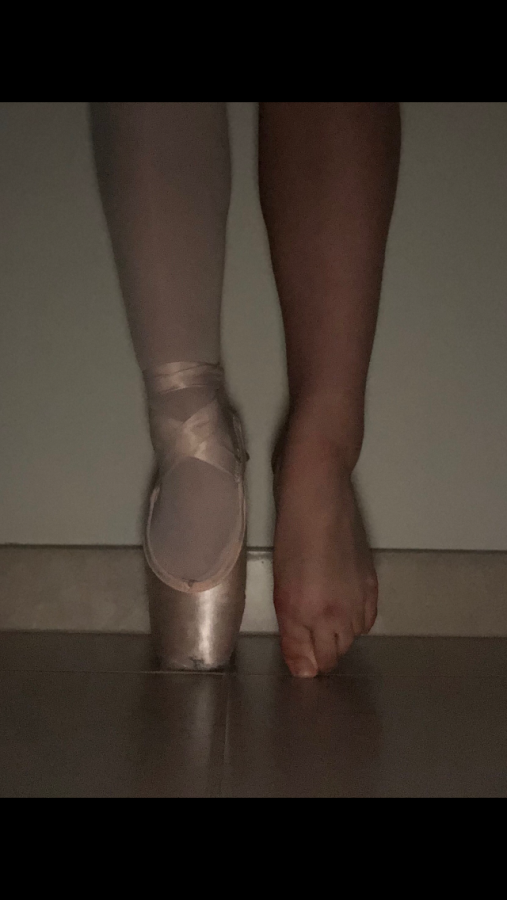To ballet or not to ballet
Freshman Kiara Nelson has been dancing since before she can remember. After all of this time, she barely notices the pain of all her weight forced onto one toe. Instead, this pain means to her that she is beautiful, that she is graceful. She is in her element.
As Nelson methodically turns and bends to the music, the moves flow naturally as she interacts with the nearby dancers. The choreography for this showcase has been drilled into her muscles, and she acts without thinking. Her arms gracefully fly in soft angles and agile circles while her feet jump and kick, slender and strong. Her partners’ arms grip her waist and hoist her into the air.
This is Nelson’s favorite part. She is high off the ground, spinning and contorting in complete trust of the person holding her up. If her muscles did not burn from the effort, she would stay up here forever.
Unfortunately, ballet is more than just an elegant art. It is incredibly time consuming and an activity that tends to take over dancers’ lives. Nelson dances six days a week, up to six hours on some days. Still, this constant business does not push her away. “Ballet is a way for me to be free from my everyday life,” Nelson said. “Everything revolves around ballet, because you can’t do it quick. But it’s so worth it.”
Nelson is not alone, most ballerinas spend all of their time at studios: rehearsing, training, taking classes or performing. Although they put plenty of thought and practice into the on-stage performance, the bulk of their time is spent preparing, not performing. Freshman Bella Courard-Durso has been dancing and performing since she was three. “Performing feels like a party.” Durso said. “Everyone is so tired and sweaty but it’s so fun because you get to appreciate how fun it is.”
Ballet does not only consume time, but also the health of many ballerinas, making it important to consider its physical implications. On top of the physical damage ballet can cause, it has been known to cause psychological problems in dancers as well. A study published last year by the Superior Institute of Miguel Torga in Portugal about the psychology of music found that ballet can be very problematic.
“Evidence from dance practice, especially among ballet students, shows an association with mental health problems,” the study said. “Psychological inflexibility involves cognitive fusion, which is an excessive involvement with internal events, leading to experiential avoidance.”
However, as ballet evolves and changes with the time, expectations placed on ballerinas are changing. “It used to be that all dancers should look like Russian dancers, who are typically very skinny.” Nelson said. “More recently, muscular dancers have been more accepted, like Misty Copeland.”
However, body shape isn’t the only physical problem that ballet causes. Eventual effects of the long term demands of dancing lead to join problems, imbalances and a lot of pains that come with overuse and falls. “In January, I sprained my ankle right before a big competition while dancing.” Nelson said. “When dancers get injured, the natural instinct is to push through, so when you can’t, you just sit there. It’s very hard to just sit and watch.”
By nature, ballet requires the body to contort in unnatural ways that can cause harm over time. “Ballet is really taxing on the body and I got hurt very often,” freshman Leah Karush said. “It’s because of ballet that my joints are a lot weaker, and ballet in general is really not good for your body, feet, or leg muscles because it trains them in such a specific way.”
One large impact that ballerinas both see and feel is the effects that dancing, especially pointe (dancing on the tips of the toes), has on their feet. Ballerina’s feet are painful, blistered, bruised, and yet incredibly strong. According to sports medicine podiatrist Georgina Barr, ballet most frequently causes calluses, corns, ingrown toenails, cuboid syndrome (pain through the middle of the foot) and stress fractures, some of which can require surgery or end a dancer’s career. “There are certain parts of it that you just have to get over.” freshman Eleni Donias-Mozingo said. “The pain will always be there, you are just going to have to suck it up.”
While some love the difficult demands of ballet, it is often too much for others. Constant demands on dancers’ time, bodies, and skills can be very taxing. Karush danced for 10 years until deciding to quit at age twelve, which proved very difficult. “It was such a hard decision. I was sobbing. It was the hardest decision of my life because I devoted my life to it for 10 years.” Karush said. “It was more than most of my life, it was all my life. Afterwards, I felt sad but super relieved.”
For Karush, ballet culture was not right. But for many others, it is. “I love ballet because it allows me to express myself in a way words really cannot,” Mozingo said.













